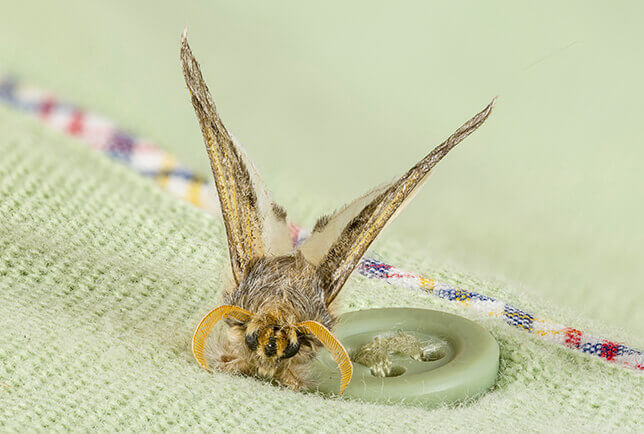What Do Clothes Moths Look Like?

While there are different types of clothes moths, the webbing clothes moth is the most common one in New England. When fully grown, the pests are a half-inch in length and a beige to golden color. You can distinguish these moths from similar insects by the fringed hairs on their wings.
Climate-controlled homes and businesses offer these insects a comfortable spot to breed year-round. Females lay anywhere from 40 to 50 eggs at a time. Once they hatch, the larvae are about half an inch long and have white bodies and brown heads. This is the most destructive phase as the young feed on fibers such as fur, wool, silk, feathers, and leather.
How Can I Tell if I Have a Clothes Moth Problem?
Unlike similar insects, clothes moths avoid light, preferring dark basements, attics, and closets. As a result, it can be difficult to detect at first. However, there are a few tell-tale signs of an infestation:
- Adults – Though they don’t cause damage, if you see an adult, odds are that there are larvae nearby. Poor fliers, these pests often scurry away instead of taking flight.
- Webs and Waste – Webbing clothes moths leave a silky web on clothing or the underside of carpeting as they feed. You may also find fecal pellets.
- Damage – Larvae often leave holes and threadbare spots around collars, cuffs, and the hems of stored garments and fabrics.
How Do Clothes Moths Get Inside Homes and Businesses?
Finding a way into homes for a clothes moth is simple due to the insect’s small size. Gaps around doors, poorly screened chimneys, and foundation cracks all give these pests an opening. You may also bring clothes moths into your home by accident when you purchase vintage furniture and clothing.
Businesses are also susceptible to clothes moths. They can get in through spaces around pipes, wires going into buildings, or store entrances and exits. Thrift and consignment shops are especially vulnerable to infestation since they specialize in used items that are more likely to have a clothes moth infestation.
Are Clothes Moths Dangerous?
While not a health threat, larvae may damage precious keepsakes and valuable furnishings beyond repair. If improperly stored, these pests can destroy an entire article of clothing, a tapestry, or animal furs. Clothes moths will feed on carpeting or a couch as well, resulting in expensive repairs.
Due to their destructive nature, clothes moths can be a costly issue for many businesses. Establishments that sell garments, rugs, and textiles made from organic materials, such as wool or silk, should be wary of infestations. If a company does have clothes moths, there is a risk for a loss of products and profits.
How Can I Prevent Clothes Moth Infestations?
Prevention is the best method to deter clothes moths. If you need to store clothes or blankets, use plastic containers with tight-fitting lids. For businesses, routinely check for signs of the pests and ensure products have a secure seal. If your clothes moth problem persists, call Waltham Pest Services to consult with an expert about the best methods for removal.